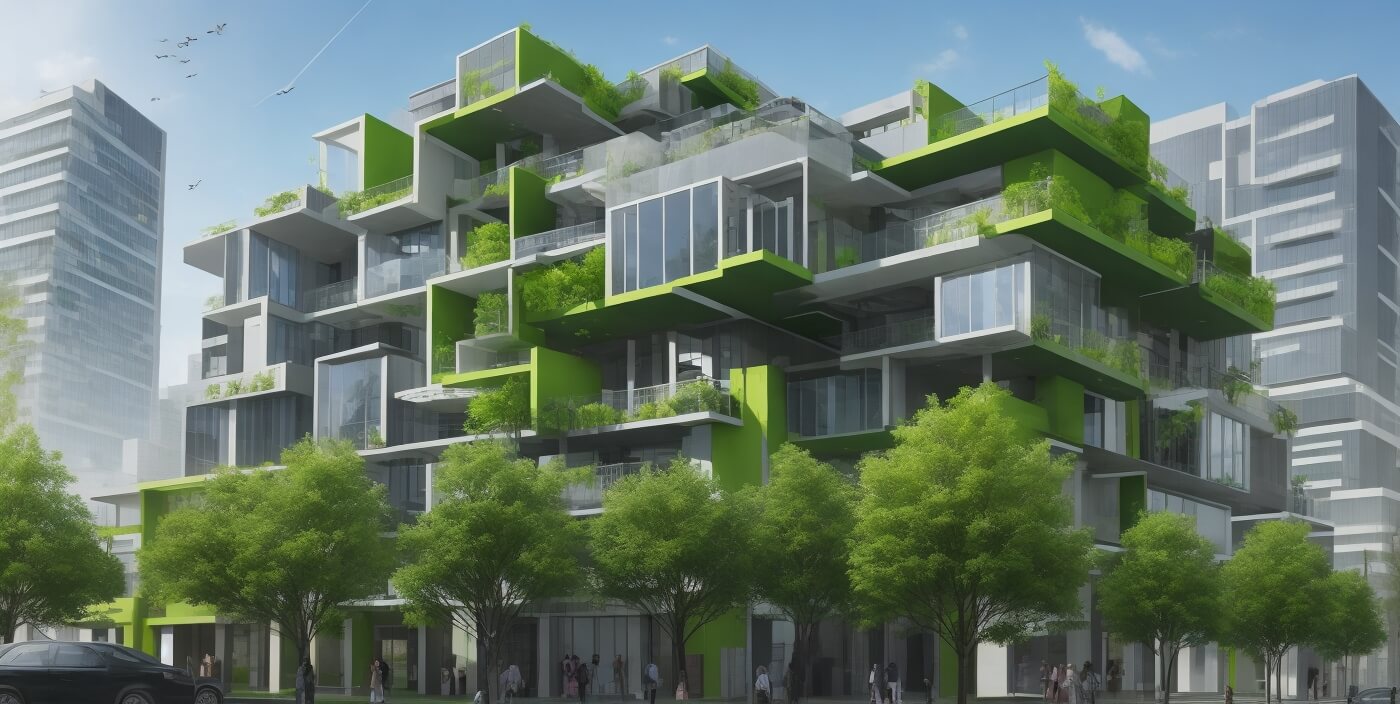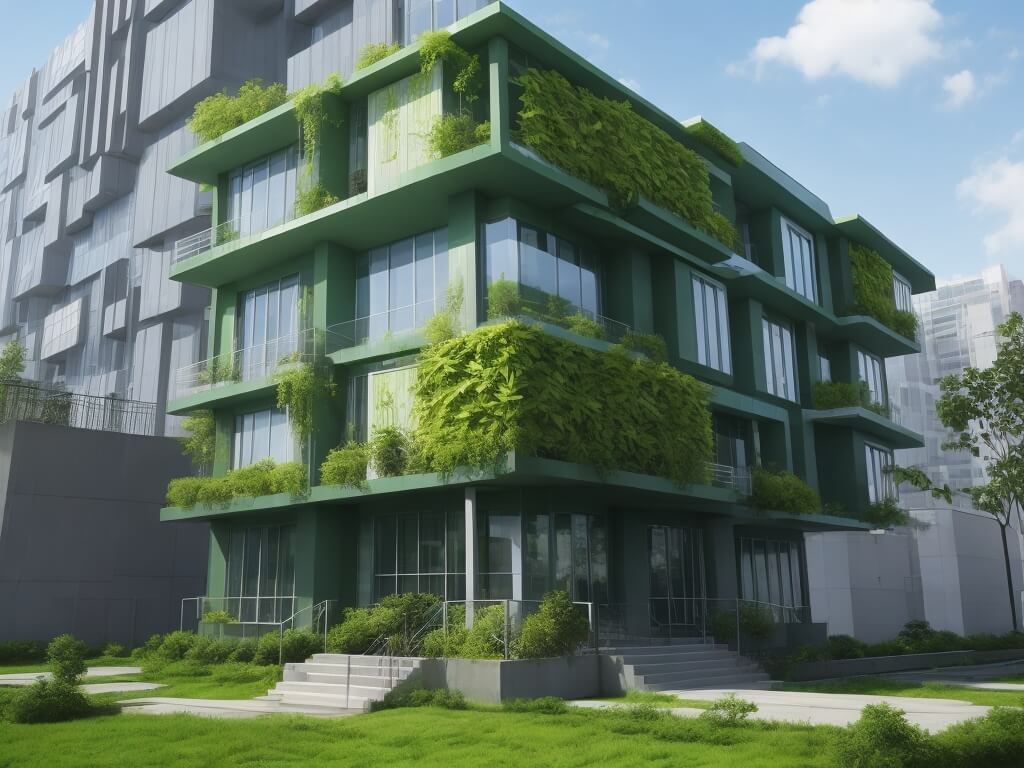
Green building design, often referred to as sustainable architecture, is rooted in the principle of minimizing environmental impact. Traditional construction methods often result in excessive resource consumption, emissions, and waste, contributing to global environmental challenges. Green building design, on the other hand, places a strong emphasis on sustainability, working in harmony with nature rather than against it.
Our planet faces a growing crisis due to the depletion of natural resources, increasing carbon emissions, and the degradation of ecosystems. Traditional construction practices exacerbate these problems, but green building design offers a path toward mitigation and positive change.
By focusing on sustainability, green building design seeks to reduce the impact of construction and the long-term operation of buildings on the environment. This approach aligns with the urgent need to combat climate change and protect the natural world. It’s about rethinking how we build, embracing innovation, and making choices that benefit both people and the planet.
Green building design addresses issues like energy consumption, water use, waste management, and indoor air quality. It encourages the use of renewable energy sources, efficient insulation, and sustainable materials, all aimed at reducing the carbon footprint of a building. This environmentally conscious approach doesn’t just lower operational costs for building owners, it also contributes to a healthier, more sustainable future.
Energy Efficiency at the Core
One of the fundamental elements of green building design is a focus on energy efficiency. This means designing and constructing buildings that maximize energy conservation, reduce energy consumption, and harness renewable energy sources. By adopting this approach, we can significantly cut down on our carbon footprint and decrease reliance on fossil fuels, which are major contributors to greenhouse gas emissions.
Efficient Insulation
Green building design begins with efficient insulation. Proper insulation ensures that buildings maintain a consistent temperature, reducing the need for heating or cooling. By reducing the energy required to maintain a comfortable interior climate, green buildings decrease energy consumption, resulting in substantial savings and a lighter environmental footprint.
Sustainable Materials
Sustainable materials like recycled steel, bamboo, and reclaimed wood are not only environmentally friendly but also energy-efficient. They reduce the energy needed for production, transportation, and disposal, ultimately contributing to lower energy consumption over the building’s lifespan.
Passive Solar Design
Green buildings often incorporate passive solar design principles. This means optimizing a building’s layout, windows, and orientation to take advantage of natural sunlight and heat. By allowing sunlight to naturally illuminate and warm the interior spaces, green buildings reduce the reliance on artificial lighting and heating systems, again cutting energy costs.
High-Efficiency HVAC Systems
Heating, ventilation, and air conditioning (HVAC) systems are among the largest energy consumers in a building. Green building designs feature high-efficiency HVAC systems that use less energy to maintain comfortable indoor temperatures. These systems are not only energy-efficient but also offer improved air quality.
Renewable Energy Sources
Incorporating renewable energy sources, such as solar panels or wind turbines, is a hallmark of green building design. These sources generate clean energy on-site, reducing the building’s reliance on fossil fuels and lowering its carbon footprint. Surplus energy can often be fed back into the grid, providing a green energy source for the community.
Economic Benefits
Green building design doesn’t just benefit the environment; it also makes economic sense. While the initial cost of construction may be slightly higher, the long-term savings are substantial. Reduced energy consumption means lower utility bills, and the use of sustainable materials can result in lower maintenance costs. Additionally, green buildings often enjoy higher property values and can attract environmentally conscious tenants.
Health and Wellbeing
With improved air quality, natural lighting, and comfortable indoor temperatures, green buildings provide a better living and working environment. This can lead to increased productivity, reduced sick days, and a generally happier and healthier population.
When we talk about green buildings, we often highlight their role in reducing energy consumption and environmental impact. However, it’s equally important to consider the impact of these designs on human health and wellbeing.
One of the key aspects of green building design that contributes to human health is the focus on indoor air quality. Green buildings incorporate advanced ventilation systems and low-VOC (volatile organic compound) materials, which reduce indoor air pollution. Cleaner air has a direct positive impact on respiratory health and overall wellbeing. In traditional buildings, inadequate ventilation and the use of materials with high VOC levels can lead to various health issues, including allergies and respiratory problems.
Natural lighting is another element of green building design. These buildings maximize the use of daylight, reducing the need for artificial lighting during the day. Exposure to natural light has been linked to improved mood, enhanced concentration, and increased productivity. It can also help regulate the body’s circadian rhythms, leading to better sleep patterns and overall health.
Temperature control is also crucial for occupant comfort and health. Green buildings often incorporate features like better insulation, high-efficiency windows, and advanced HVAC systems. This results in more consistent indoor temperatures, reducing the likelihood of discomfort due to extreme heat or cold. Maintaining comfortable indoor temperatures not only enhances wellbeing but also minimizes stress and the risk of heat-related illnesses.
In addition to physical health benefits, green building design can have a positive impact on mental health. The connection to nature, prevalent in green spaces through the use of natural materials and landscaping, has been shown to reduce stress and promote a sense of wellbeing. Access to outdoor spaces, green roofs, and urban gardens can further improve mental health by providing places for relaxation and recreation.
When occupants of green buildings experience better health and wellbeing, it can lead to increased productivity and reduced sick days. Employees in green-certified office buildings report higher job satisfaction and better cognitive function, which can ultimately benefit businesses. In residential green buildings, residents often enjoy a higher quality of life with reduced healthcare expenses
Government Incentives
Governments worldwide are recognizing the importance of green building design and are offering various incentives to promote its adoption. These incentives can include tax breaks, grants, and expedited permitting processes. By choosing to build green, individuals and organizations can take advantage of these programs, further enhancing the financial benefits of energy-efficient design.
The adoption of green building design is not only driven by environmental and health considerations but also by a growing recognition of its economic advantages. In this context, governments around the world are playing a crucial role in incentivizing the construction of sustainable, energy-efficient buildings.
One of the primary ways governments encourage green building practices is through tax incentives. These tax breaks can come in various forms, such as credits or deductions for energy-efficient features or renewable energy installations. For example, in the United States, the federal government offers tax credits for residential and commercial properties that incorporate energy-saving technologies like solar panels and efficient HVAC systems. These incentives can significantly reduce the upfront costs of green building and provide a compelling financial reason for individuals and businesses to invest in energy-efficient designs.
Grants and subsidies are another powerful tool in a government’s arsenal to promote green building. Many countries offer financial assistance to individuals and organizations that commit to sustainable construction practices. These grants can cover a portion of the construction costs, making green building more accessible and affordable. Such financial support is especially valuable for smaller businesses and homeowners looking to make eco-conscious upgrades to their properties.
Expedited permitting processes are yet another way governments promote green building. By streamlining the approval and permitting procedures for green construction projects, authorities can reduce delays and administrative burdens. This not only saves time but also lowers construction costs, making it more attractive for developers and homeowners to embrace energy-efficient building practices.
Some local governments offer density bonuses, which allow builders to construct larger or more units in exchange for incorporating green building features or providing community benefits. These bonuses can be a win-win, as they encourage sustainable development while helping to address urban housing challenges.

